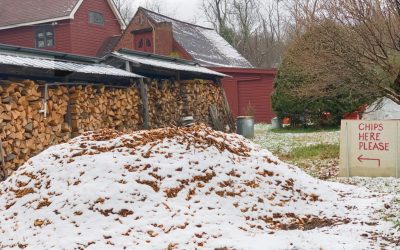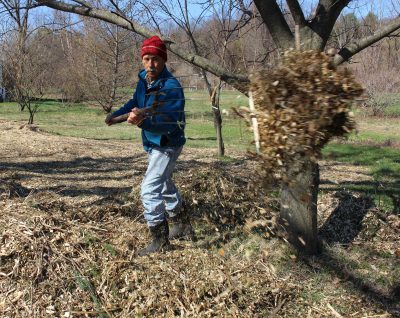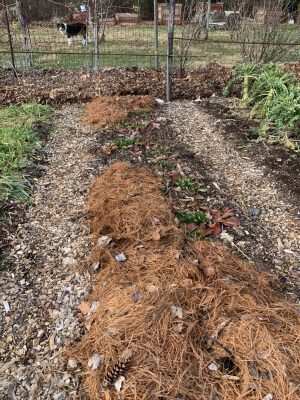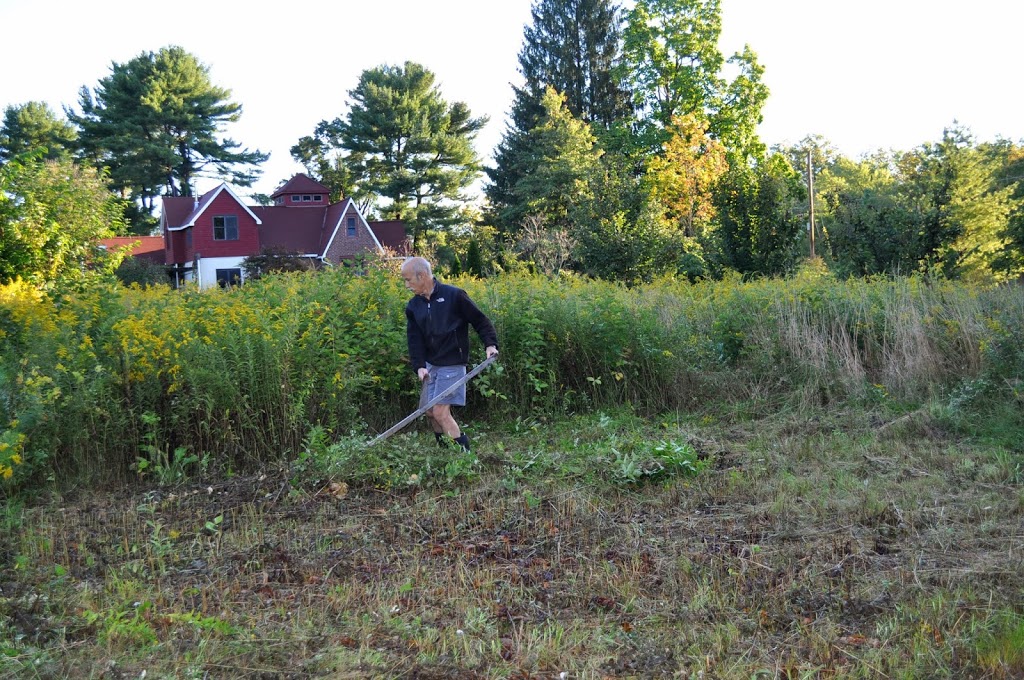CLOSING “SHOP”
Chips, Not Hay, In This Case
“Make hay while the sun shines.” Good advice, literally in agriculture and figuratively in life. And I’m following it these days, in agriculture. Not making hay of course, because that sunshine is only effective in summer and fall, partnered with heat.
The “hay that I’m making” is actually mulch that I’m spreading. A few weeks ago I put my “WOOD CHIPS WANTED” sign out along the road in front of my house. In a short time, an arborist was kind enough deposit a truckload of chips.  I figured I could spread it on the ground beneath some of my trees and shrubs, especially the youngest ones. There, next summer, the mulch would keep weeds at bay, slow evaporation of water from the ground, and feed soil life, in so doing enriching the soil with nutrients and organic matter.
I figured I could spread it on the ground beneath some of my trees and shrubs, especially the youngest ones. There, next summer, the mulch would keep weeds at bay, slow evaporation of water from the ground, and feed soil life, in so doing enriching the soil with nutrients and organic matter.
Usually, by this time of year, my piles of wood chips have frozen solid or are white mounds beneath snowy blankets. Not so this year.
So I’ve been loading up garden cart after garden cart with chips to haul over to the garden. (Once the ground disappears beneath a heavy, white layer of snow, moving heavy cartloads becomes nearly impossible.)
Since the most important trees and shrubs had already been mulched earlier in autumn, I decided it was a good time to add a layer of chips to the paths in the vegetable garden. Chips there are mostly to suppress weeds which thrived with last season’s unusually abundant rainfall and to soften, by spreading out, the impact of footfall on the paths. I generally “chip the paths” every couple of years at a minimum if for nothing more so that the height of the paths keeps up with the rising height of the vegetable beds which get — and already got, at the end of this season — a one-inch deep blanket of compost annually. (Besides the usual benefits of mulches, the compost provides enough nutrients for the intensively planted vegetables for the whole season. No fertilizer per se is needed.)
Chips there are mostly to suppress weeds which thrived with last season’s unusually abundant rainfall and to soften, by spreading out, the impact of footfall on the paths. I generally “chip the paths” every couple of years at a minimum if for nothing more so that the height of the paths keeps up with the rising height of the vegetable beds which get — and already got, at the end of this season — a one-inch deep blanket of compost annually. (Besides the usual benefits of mulches, the compost provides enough nutrients for the intensively planted vegetables for the whole season. No fertilizer per se is needed.)
After decades of my adding an inch or more of wood chips to the paths and compost to the beds, you might suppose that the whole vegetable garden has risen a few feet above the surrounding area like a giant stage. Nope. The goodness of organic materials, such as the compost and wood chips, comes from soil organisms chewing them up and breaking them down. As decomposition takes place, the bulk of these materials, which are mostly carbon, hydrogen, and oxygen, is released into the air as carbon dioxide and water. The minerals that remain feed the plants.
Pine Berries?
One bed in the vegetable garden is home to strawberries. That bed also needs mulching, for different reasons and with different materials than the other beds, and needs it every year about now.
A strawberry plant is mostly nothing more than a stem, a stem whose distance from leaf to leaf has been telescoped down to create a stubby plant.  Like the stems of any other plant, a strawberry stem each year grows longer from its tip and also grows side shoots. So a strawberry stem rises ever so slowly higher up out of the soil each year.
Like the stems of any other plant, a strawberry stem each year grows longer from its tip and also grows side shoots. So a strawberry stem rises ever so slowly higher up out of the soil each year.
Strawberry stems are not super cold-hardy. As a stem slowly rises higher in the ground, it’s exposed to more and more cold, and more apt to dry out.
What’s needed is to protect the stems with an insulating blanket of some loose organic material. Straw is traditional — and one possible root of the name “strawberry” — but good straw reliably free of weed seeds is hard to find. Instead of straw, I often use wood shavings, conveniently available in bagged bales. This year I decided that the giant pine tree here could spare a few pine needles, raked up to share with the strawberries.
The goal of mulching strawberries isn’t to keep cold out, just to moderate the bitterest cold.  Mulching too early might cause the stems to rot. I typically wait until the ground has frozen about an inch deep which usually occurs towards the end of December here, and then cover the plants with about an inch depth of wood shavings.
Mulching too early might cause the stems to rot. I typically wait until the ground has frozen about an inch deep which usually occurs towards the end of December here, and then cover the plants with about an inch depth of wood shavings.
Come spring, the mulch needs to be pulled back before the plants start growing. Tucking the mulch in among the plants provides the usual benefits of mulch, especially important for strawberries because of their shallow roots, and provides a nice, clean bed on which the ripening berries can lie.
(More about growing strawberries can be found in my book GROW FRUIT NATURALLY.)
Hey, Good Looking
I admire the look of my vegetable gardens this time of year. With the chipped paths and compost lathered beds, some also with a tan cover of winter-killed oat plants, they look very tidy and ready to welcome new seeds and transplants in the months ahead. The look doesn’t compare with the lush greenery and colorful fruits of the summer garden, all of which is nothing more than a memory.





We just had some trees taken down that were is danger of falling and besides cutting most into manageable lengths for the fireplace, the rest were chipped. We were advised by the arborist to let the chip pile sit for a year before using it near plants. He said it leaches too much nitrogen from the soil until it ages somewhat. What’s your advice, thanks
That’s a common myth, about fresh bark leaching nitrogen. Actually, what he really means is that it ties up nitrogen. Chips are high in carbon, low in nitrogen. Microbes that decompose the chips need both nutrients and, since the chips are low in nutrients, they take what nitrogen they need from the soil. They are more able to take that nitrogen than plants so plants get starved for nitrogen. Only for awhile though, until the nitrogen is re-released into the soil as the microbes die off. BUT . . . all this happens only when chips are mixed into the soil. When laid on top of the ground as mulch, the decomposition is very slow and mostly at the interface so that nitrogen is re-released at about the rate that it’s tied up. To sum up: Mulching with fresh or decomposed wood chips is not a problem. Use it.
I am hoping to attend a tour of your garden next year. Hopefully when the pandemic is in remission.
Yes. I’m hoping to have you and others here when the coast is clear.
Where do you get ‘wood shavings?’
Most feed stores should stock bales of them.
Bet your beds are white this morning! (Dec 17).
Please follow up this spring with the pine needle coverage. I tried this after seeing it used in Louisiana–they buy ‘bales’ of pine needles at garden centers. My flowers did so-so, but it kept every seeding from growing (?acid in the needles?)
I did not use a second year. (I live in Utah–Vanderwolf pine shed needles regularly, so I have plenty.
Trina White–Huntsville Utah
Pine needles do not really acidify the soil. Perhaps they encouraged slugs, which ate the seedlings. Did a different mulch have the same effect?
Lee,
I also use wood chips in my garden paths. I enjoy being able to go out to harvest and not getting muddy or compacting the soil as much. But the one issue I have with it is in the spring. Slugs! I’m on constant slug patrol with my brassicas especially. Do you have this problem using wood chips? If so, any advice on keeping them at bay?
Oddly enough, I don’t have hardly any problem with slugs. Perhaps it’s because, for years, whenever I came upon a toad anywhere, I would pick it up gently and put it in the garden. There are some non-poisonous slug baits you could use, such as those with ferrous (iron) sulfate.